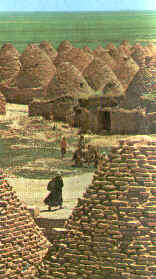|
|
Boldly contoured in crayon colors of ash gray, rust-red and tawny yellow, the great mass of Eastern Anatolia stretches away from the central plateau to the snow-capped peaks of Eastern borders.
It is region with turbulent pass as the battlefront of Eastern and Western cultures, between Romans and Parthian and Byzantine and Sassanids, culminating in final conquest of Anatolia by Eastern people, Seljuk Turks.
In the area where the central steppe gives way to the more mountainous terrain of East are the interesting former Seljuk centers of Sivas, Divrigi, Eski Malatya (outside modern Malatya) and Harput (outside Elazig).
At the height of 1950 m is Erzurum, called by Seljuk "Arz er Rum" or "Frontier of West", and which possesses several Seljuk and Mongol buildings. To the North is the much fought over frontier city of Kars, dominated by formidable fortress, and near which are the ruins of 10th century Ani.
Overshadowed by Agri Dagi (5165 m), Ararat Mountain where Noah's Ark came to rest, is the intriguing mosque and palace of Ishak Pasha at Dogubayazit. On the banks of the vast Lake Van is the city of same name, with its Urartu Citadel dating back to 1st millennium BC, On Akdamar Island in the lake is the fascinating 10th century Church of Holy Cross.
In the region that was once Upper Mesopotamia in the basin of Tigris and Euphrates are the cities of Diyarbakir, Mardin and Urfa, all centers of Hurri-Mitanni in 2nd millennium BC.
Diyarbakir is characterized by its massive black basalt walls, while Mardin's striking mediaeval architecture is peculiar to this city alone. Ufra is famed for its pool of scared carp, beside the Mosque of Abraham.
In the mountain vastness of South-East is one of Turkey's most spectacular monument, Commagene Sanctuary of Nemrut Dagi with its colossal toppled heads of gods.

Harran
|
|

